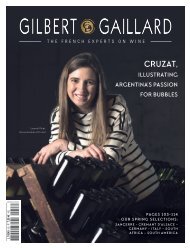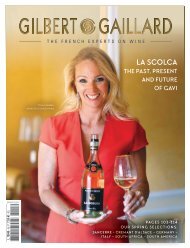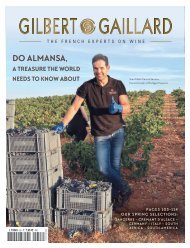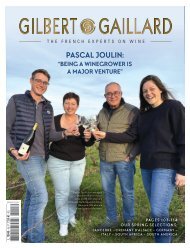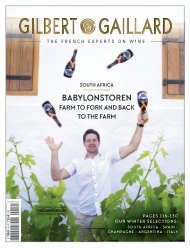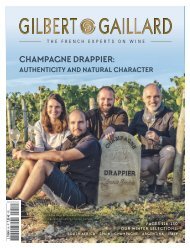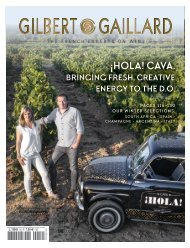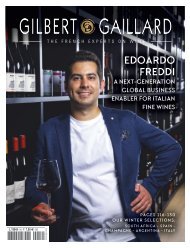FRA_GG_N46-WEB
The GILBERT & GAILLARD International Magazine : Make some room in your lounge for WINE REGIONS from around the world
The GILBERT & GAILLARD International Magazine :
Make some room in your lounge for WINE REGIONS from around the world
Create successful ePaper yourself
Turn your PDF publications into a flip-book with our unique Google optimized e-Paper software.
CHAMPAGNE<br />
– STYLES –<br />
an opportunity for winegrowers to put the finishing<br />
touches to their work. Some use concentrated grape<br />
must, whilst others add mature wines, Cognac or honey<br />
from their own estate.<br />
This ‘recipe’, which has been copied countless times<br />
around the world, is called the ‘traditional method’. But<br />
Champagne is constantly mindful to ensure that it alone<br />
can call the technique the ‘Champagne method’.<br />
BOLLINGER: COMPLEX BLENDS AND SINGLE-<br />
VINEYARD AMBITIONS<br />
Bollinger, which is located in Aÿ, was founded in<br />
1829. It owns 178 hectares of vines and buys grapes<br />
in roughly the same proportions. Deputy cellar master<br />
Denis Bunner answers our questions. Formerly with the<br />
Champagne wine marketing board, as a winemaker, his<br />
first question after he joined Bollinger was, What is the<br />
Bollinger style? How can it be defined?<br />
Joint research work provided the answer – “fruit in all<br />
its phases”, in other words, fresh, ripe and dry. Fresh<br />
fruit aromas come from the year’s wines. To preserve<br />
them, the wines are made in stainless steel tanks. The<br />
ripe fruit aromas come from reserve and oak-fermented<br />
wines – the house uses a staggering 4,000 casks! Finally,<br />
the dried fruit aromas and toast can be credited to the<br />
reserve wines stored in magnums. This technique is<br />
novel because reserve wines are usually stored in large<br />
inert tanks. Here, though, they are stored on their lees in<br />
small containers of 1.5 litres with a cork stopper stapled<br />
in place. They then represent between 5 and 10% of the<br />
Spéciale label. The wine – the house’s non-vintage Brut<br />
– contains at least 60% Pinot noir and accounts for 80%<br />
of the range. It is stored for three years for the secondary<br />
fermentation and then around 6g per litre of sugar is<br />
added for dosage.<br />
Bunner explains how the ideal dosage is defined by<br />
tasting a flight blind where dosage ranges from 0 to 10g.<br />
Until fairly recently, dosage of 7 or 8g was the preferred<br />
choice, so why is it now only 6g? Quite simply because<br />
the base wines are naturally riper and require less dosage.<br />
This is just a tiny glimpse of the incredible work carried<br />
out in the winery, then blending by Bollinger.<br />
The house is also innovating. The vast majority of<br />
Barrels at Maison Bollinger which has its own cooperage<br />
The 4,000 barrels at Maison Bollinger<br />
WINTER 2021 GILBERT & GAILLARD - THE FRENCH EXPERTS ON WINE 13









